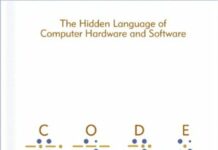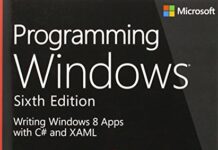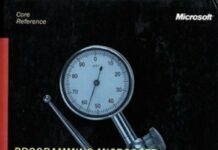
Ebook Info
- Published: 2008
- Number of pages: 384 pages
- Format: PDF
- File Size: 12.04 MB
- Authors: Charles Petzold
Description
Programming Legend Charles Petzold unlocks the secrets of the extraordinary and prescient 1936 paper by Alan M. TuringMathematician Alan Turing invented an imaginary computer known as the Turing Machine; in an age before computers, he explored the concept of what it meant to be computable, creating the field of computability theory in the process, a foundation of present-day computer programming.The book expands Turing’s original 36-page paper with additional background chapters and extensive annotations; the author elaborates on and clarifies many of Turing’s statements, making the original difficult-to-read document accessible to present day programmers, computer science majors, math geeks, and others.Interwoven into the narrative are the highlights of Turing’s own life: his years at Cambridge and Princeton, his secret work in cryptanalysis during World War II, his involvement in seminal computer projects, his speculations about artificial intelligence, his arrest and prosecution for the crime of “gross indecency,” and his early death by apparent suicide at the age of 41.
User’s Reviews
Editorial Reviews: From the Inside Flap Before digital computers ever existed, Alan Turing envisioned their power and versatility…but also proved what computers could never do.In an extraordinary and ultimately tragic life that unfolded like a novel, Turing helped break the German Enigma code to turn the tide of World War II, later speculated on artificial intelligence, fell victim to the homophobic witchhunts of the early 1950s, and committed suicide at the age of 41. Yet Turing is most famous for an eerily prescient 1936 paper in which he invented an imaginary computing machine, explored its capabilities and intrinsic limitations, and established the foundations of modern-day programming and computability.This absorbing book expands Turing’s now legendary 36-page paper with extensive annotations, fascinating historical context, and page-turning glimpses into his private life. From his use of binary numbers to his exploration of concepts that today’s programmers will recognize as RISC processing, subroutines, algorithms, and others, Turing foresaw the future and helped to mold it. In our post-Turing world, everything is a Turing Machine — from the most sophisticated computers we can build, to the hardly algorithmic processes of the human mind, to the information-laden universe in which we live. From the Back Cover Before digital computers ever existed, Alan Turing envisioned their power and versatility…but also proved what computers could never do.In an extraordinary and ultimately tragic life that unfolded like a novel, Turing helped break the German Enigma code to turn the tide of World War II, later speculated on artificial intelligence, fell victim to the homophobic witchhunts of the early 1950s, and committed suicide at the age of 41. Yet Turing is most famous for an eerily prescient 1936 paper in which he invented an imaginary computing machine, explored its capabilities and intrinsic limitations, and established the foundations of modern-day programming and computability.This absorbing book expands Turing’s now legendary 36-page paper with extensive annotations, fascinating historical context, and page-turning glimpses into his private life. From his use of binary numbers to his exploration of concepts that today’s programmers will recognize as RISC processing, subroutines, algorithms, and others, Turing foresaw the future and helped to mold it. In our post-Turing world, everything is a Turing Machine — from the most sophisticated computers we can build, to the hardly algorithmic processes of the human mind, to the information-laden universe in which we live. About the Author English mathematician Alan Turing (1912–1954) is the author of the 1936 paper “On Computable Numbers, with an Application to the Entscheidungsproblem” that introduced the imaginary computer called the Turing Machine for understanding the nature and limitations of computing. His famous 1950 article “Computing Machinery and Intelligence” introduced the Turing Test for gauging artificial intelligence. American writer Charles Petzold (1953–) is the author of the acclaimed 1999 book Code: The Hidden Language of Computer Hardware and Software, a unique exploration into the digital technologies of computers. He is also the author of hundreds of articles about computer programming, as well as several books on writing programs that run under Microsoft Windows. His Web site is www.charlespetzold.com. Read more
Reviews from Amazon users which were colected at the time this book was published on the website:
⭐This is an absolutely fantastic book, providing far more than an annotation of Turing’s famous ’36 paper. Sure, it goes line by line through Turing’s paper, and explains every nuance of the original in depth. However, it goes above and beyond by providing solid historical context, loads of information on Turing’s contemporaries and influences, as well as delving deeply into the philosophical ramifications of the theory on computer intelligence and consciousness. The author cites many related books and papers, providing a wealth of information for continued study. The book was a joy to read.The only slight negative is the physical construction of the paperback book. The pages are a bit thin, with some bleed-through, and the cover scratches easily. However, the font is a nice, legible size. It is not the worst binding, but it could be better. Besides the binding, I found this book to be superior in every way to “Turing’s Vision: The Birth of Computer Science”.
⭐I have a very firm belief that most books, documents, or textbooks on mathematics or the sciences are written by people without souls. This is certainly not one of those books.From the very beginning the author provides very clear and informative summaries, illustrations, and examples so that you can digest one of the most important mathematics papers of the 20th century. He even throws in some subtle humor in the mix (it’s easy to miss!). Each successive chapter should leave you with some sense of interest/amazement or thoughts of, “why didn’t I think of this?” By the end you will understand how a computer works at its very core.I would strongly recommend this book to anyone who is interested in computers or the foundations of mathematics. It will give deeper insights what computers and humans can, and will never be able to do.One last note: there are certain points in the book (especially near the end) which can be difficult to parse. I would recommend anyone who does not understand first order logic to a great degree to not worry about understanding all the details, but accept the author’s commentary and move on, especially if you’re reading it for the first time. You should first try to understand the big picture before worrying about the nitty-gritty, and the book will be more enjoyable that way.
⭐Don’t let the title fool you: This isn’t simply Alan Turing’s groundbreaking paper “On Computable Numbers, with an Application to the Entscheidungsproblem” with a handful of footnotes thrown in. While the paper is contained here in its entirety, there is, on average, about a paragraph of explanation for each line of Turing’s prose. And before that, there is an extensive introduction to important concepts, starting with the distinctions between rational, irrational, algebraic, transcendental, and computable numbers–all explained in terms that any intelligent undergraduate should be able to understand. No mathematical background is assumed beyond algebra.The Annotated Turing exceeds even the best undergraduate textbooks in explaining these concepts clearly yet concisely, and in doing so sets up the historical context that Turing worked in. When there is an interesting story to tell about Hilbert or Russell, he tells it. (Russell’s life was, after all, sufficiently fascinating to be the subject of a recent comic book,
⭐.) Those with a more extensive mathematical background will want to skim the early sections, but shouldn’t skip them entirely.What Douglas Hofstadter’s
⭐did for Gödel’s Incompleteness Theorem–a crucial discovery that was poorly understood outside of the domain of professional mathematicians–Petzold’s book does for Turing’s universal computer. If you have any interest whatsoever in the theory of computing, make this the first book you read.
⭐I studied the Turing papers in college. Only some 50 pages long, no explanations, hard to understand. Another book said this was the best source on the subject, so I am trying it again. These are the ideas that were used in designing the computer. Finite automata, etc.
⭐This is an incredible book! As a researcher in quantum information coming in with a background in physics, this helped tie together a lot of disparate knowledge I’ve had about theoretical computer science. The story of how this entire field was motivated, and the complete pure badassery of our Lord & Savior, David Hilbert, was just a joy to read. I read through half the book in about a week!Highly recommend to anyone wanting a firmer grasp on what computer science is really all about.
⭐I’ll be honest, I am not a mathematician but I like mathematics, partly because I love computer programming. If I read the Turing paper as is, I would not understand it, but the way Petzold is explaining things makes it all easy to understand. You feel this is his toy project, his hobby.I own two other books by him :
⭐and
⭐and everywhere when it comes to math the author explains things in a way that even a newbie to the subject(say matrices) could understand it.So “The annotated TURING” is fun to read, also because of the detailed historical information it contains.
⭐The quality of writing in this book is very good. I would say that some very difficult mathematics concepts and explained very clearly, especially the different types of numbers and the nature of infinity (Cantor). There is a good mix of history as well as technical discussion of Turing’s work. This book is like reading something from Feynman. If you want to start out learning something about Turing then look first to this book.
⭐I wanted to really understand Turing, not some hand-waving popular science approach. The book is certainly rigorous but I was surprised at how easy it is to read. Just the right amount of explanation for the maths. Also the biographical sections at the start of each chapter are well done and in parts very moving
⭐As part of a numerous group of programmers without a university degree in the field, it is not too easy for me to grasp the academic language of many fundamental texts. Therefore, it’s probably no surprise that I was not very satisfied after finishing Turing’s paper. I got the main idea, sure, but I did not have the patience and diligence required to decipher his machine descriptions and truly grasp the monumental achievement which this paper represents.I recently read Code: The Hidden Language of Computer Hardware and Software, and was fascinated by it. Here, Petzold again grabbed my attention and held it for almost the entirety of the book (almost, since some portions are more difficult than others, but not excessively so). He takes Turing’s paper, and the correction published a year later, and dissects them vigorously, presenting a lot of background knowledge, historical events and plenty of illustrative examples.The best word I can use to summarize is: Wow. This is the kind of book which leaves you feeling good about yourself. To someone like me, lacking any formal education in information theory, mathematical logic and all the other subjects more or less present in a CS course, this is a must-read.Therefore, as stated in the headline, if you’re here, reading this book’s description and trying to decide whether it’s worth it – it truly is. Even if, unlike me, you’re able to fully comprehend On Computable Numbers, you’ll probably learn a lot from it, or, at the very least, enjoy the read.
⭐* SynopsisThe author gives insight into the man and his most influential work. Turing’s contribution work with cracking the Enigma is on record to have shortened the WW2 by 2 years.* Topics covered1 Foundations, 11 Computable Numbers, 111 Das Enscheidungsproblem 111v And beyond.* CommentaryI bought this book to have insight into Turing’s paper on how to make a universal Turing machine, or what is now known as a computer. The book covers the man’s history and his works in a delicate way that has a way explaining that makes light of it. And a much better job of simplifying the work of the genius computer scientist so the reader can feel the possibilities of the work. This is limited as the author says, and I quote, ‘Because the Universal Machine is so essential to Turing’s arguments in the rest of his paper, he proves the existence of such a machine by actual constructing it in full excruciating details. Once you understand the basic mechanism, however, you might find these details to be rather tedious. No one will punish you if you don’t assimilate every symbol and function in Turing’s description.’ (P149)The author of this book is a surprisingly good explainer of the man’s work and the book is easy to read. Around the time of Turing, the only way to the programme was in binary for simple operations and data. His research implemented subroutines, and if – then decisions. procedures structuring. The fact he was so ahead of his time and even touched on A.I. work on such primitive machines is a stunning portrait of the man. There is coverage of light computing topics such as how following computer languages influenced the current common languages.* SummaryThis book has a light touch on a deep topic of the man and his work. I read it in a few days and enjoyed it. If this statement the cracking of the Enigma shortened WW2 by two years is excepted, then this ties in with the dropping of the atomic bombs to also have shortened the war also by 2 years. The war could have been still going on to 1950, which is sobering.
⭐I am a very experienced computer programmer, but not much of a mathematician. I read Petzold’s book ‘Code’ for fun and absolutely loved it (*that* book gets 5 stars). I also know what a Turing machine is, albeit from a modern perspective. Given all that, I was curious about Turing’s original paper. Petzold does a great job of dissecting Turing’s paper, paragraph by paragraph, but the subject matter is a challenge. Gothic German! I found I was skimming bits in the hope that it would get easier. It doesn’t. So having got to the end of the book, I will have to go back and re-read it, slowly and carefully this time. I feel Petzold *could* have explained things a bit better, but then the book would have been that much larger. Too large, probably. The real problem is me – not quite smart enough and in too much of a hurry. This is a book to be read slowly, properly studying each example before moving on to the next.
⭐Turing’s 1936 Paper “On Computational Numbers” is often cited as a landmark in the history of computing, but it’s details are not widely considered or well known today. If you’re curious to know more about the Paper, and why it’s important, you can do no better than read this book. It contains a complete transcript of the original Paper, with extensive commentary and explanation from Petzold that make the Paper accessible and understandable to a wider audience (and even for specialists, this book is probably a better choice than just reading the original Paper!). Petzold’s enthusiasm for the topic shines through in an excellent writing style, striking a good balance between detailed technicalities and simpler descriptions, in a friendly helpful way that will neither confuse the layman nor bore the expert.Petzold supplies invaluable historical context: some of the developments in mathematics in the late nineteenth and early twentieth centuries that undoubtedly influenced Turing, and which appear explicitly in the paper. This is a very useful aid to understanding Turing’s paper for readers not expert in those topics of mathematics (which is almost all of us who don’t have post-graduate degrees in very specialised areas of pure maths!). But the book is definitely aimed at readers with some mathematical background and aptitude. If (UK) O-level / GCSE maths was a mystery to you, you may struggle; if you have A-level maths or computing you’ll be fine. If you’re somewhere in between, Petzold’s explanations will happily guide you through the details.Two things this book isn’t: First, if you want a book that starts from Turing’s paper then delves into even more advanced mathematical research and theories, then this isn’t the one for you (although it does helpfully include a summary of more recent work that follows on from Turing’s ideas). Second, at the other extreme: although this book includes some biographical information, if you want a detailed non-technical biography of Turing you should look elsewhere.But for all the rest of us between these two extremes, who want to understand what Turing machines are from the original source, then I wholeheartedly recommend this book.My only complaint, and a very minor one, is that Petzold’s description of Bletchley Park’s location would place it in Suffolk rather than Buckinghamshire! But given the complexity of the book’s subject matter, it is a testament to the quality of Petzold’s research that this is his only error.
⭐I needed to ensure that I fully understood the Turing Machine and this book appeared to be suitable.I have had it for two days and find it explains the principle of Turing’s machine very well and also covers concepts of programming from first principles with just digits 0 and 1 along with functionally defined m-configurations (fully explained in the text).I wish I had bought it earlier, it has certainly enabled me to fully understand Turing’s concepts.
Keywords
Free Download The Annotated Turing: A Guided Tour Through Alan Turing’s Historic Paper on Computability and the Turing Machine 1st Edition in PDF format
The Annotated Turing: A Guided Tour Through Alan Turing’s Historic Paper on Computability and the Turing Machine 1st Edition PDF Free Download
Download The Annotated Turing: A Guided Tour Through Alan Turing’s Historic Paper on Computability and the Turing Machine 1st Edition 2008 PDF Free
The Annotated Turing: A Guided Tour Through Alan Turing’s Historic Paper on Computability and the Turing Machine 1st Edition 2008 PDF Free Download
Download The Annotated Turing: A Guided Tour Through Alan Turing’s Historic Paper on Computability and the Turing Machine 1st Edition PDF
Free Download Ebook The Annotated Turing: A Guided Tour Through Alan Turing’s Historic Paper on Computability and the Turing Machine 1st Edition



